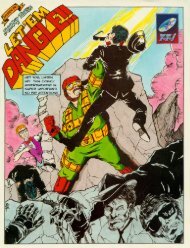4of 5 - Defunct Games
4of 5 - Defunct Games
4of 5 - Defunct Games
You also want an ePaper? Increase the reach of your titles
YUMPU automatically turns print PDFs into web optimized ePapers that Google loves.
One of the more immersive NES virtual<br />
reality experiences.<br />
The limitations of a two-dimensional<br />
television screen are obvious.<br />
In the past, game developers<br />
thought that making games more<br />
three-dimensional would be a matter<br />
of transcending those limitations. No<br />
one thought the future would be about<br />
increasing poly-counts and draw distances;<br />
instead, it would be about making players<br />
experience games as directly as they<br />
experienced the real world.<br />
Obviously, this future of “virtual reality”<br />
gaming never happened, and probably never<br />
will. The evolution of the virtual reality<br />
movement is fascinating in its own right,<br />
though, as that yearning for a more realistic<br />
gaming experience ended up directly resulted<br />
in the 3D rendered graphics we enjoy<br />
today. To emphasize the difference between<br />
3D rendered graphics and virtual reality<br />
graphics, this article is going to refer to the<br />
latter as “3-D.”<br />
Nintendo Entertainment System<br />
There are three true 3-D titles for the NES:<br />
3-D World Runner, the very popular Rad<br />
Racer, and Orb 3-D. The rst two games<br />
were developed by Squaresoft, with Acclaim<br />
publishing 3-D World Runner and Nintendo<br />
of America publishing Rad Racer. Orb 3-D<br />
was published by a company called Hi-Tech<br />
Expressions.<br />
These NES games used one of the simplest<br />
3-D techniques, anaglyph images. This technique<br />
was made famous by the 3-D movie<br />
craze of the 50’s. An anaglyph is a type of<br />
stereoscopic 3-D image created by presenting<br />
two distinctly different, but similar<br />
images of an object. The two different<br />
images are usually viewed approximately<br />
2.5 inches apart, to simulate the typical<br />
distance between the human eyes. Each<br />
image is ltered through one of a contrasting<br />
pair of colors, usually red and blue. Orb<br />
3-D came with trademarked “3-D GrenoVision<br />
glasses” that, despite the fancy name,<br />
merely replaced the traditional blue lter<br />
with a green one.<br />
The eye covered by the red lter sees only<br />
the red portions of the image, while the eye<br />
covered by the blue lter sees only the blue<br />
parts. As the eyes work to make sense of<br />
the visual stimuli, the brain interprets the<br />
color differences as the result of differences<br />
in distance. It composites the different visual<br />
data into one image, which comes into<br />
focus in three dimensions. The 3-D effect<br />
only works on a horizontal plane, so moving<br />
your head from side to side allows you to<br />
see “deeper” into the image. The ability to<br />
see 3-D anaglyphic images varies among individuals<br />
and doesn’t work for some people.<br />
To see 3-D in a game like 3-D World Runner,<br />
the player must don a pair of red/blue<br />
anaglyphic glasses that work with the color<br />
lters in the 3-D images. To enhance the effect,<br />
you should darken the room and close<br />
all of the window curtains and shades. This<br />
prevents exterior light from leaking into the<br />
room and diluting the quality of the effect.<br />
As a footnote, there is a game that could<br />
be considered the fourth 3-D title for the<br />
NES. JJ, also known as Jumpin’ Jack, was a<br />
sequel to 3-D World Runner that was only<br />
developed and released by Squaresoft for<br />
the Famicom in Japan. JJ eschewed the anaglyphic<br />
approach of previous NES 3-D titles<br />
“For extra gas, try the Orb Nachos.”<br />
38_FEATURE_LOST: VIRTUAL REALITY HARDCORE GAMER MAGAZINE_VOLUME 2_ISSUE 5_CALL CHUCK<br />
in favor of a more sophisticated technique<br />
that involved altering the refresh rate of<br />
the screen. A player who wanted to view the<br />
3-D effect wore a pair of more sophisticated<br />
3-D glasses called “shutter glasses”. More<br />
information about how shutter glasses work<br />
is contained below.<br />
GCE Vectrex<br />
The rst 3-D hardware peripheral for a<br />
console was the 3-D Imager for the GCE<br />
Vectrex, released in 1983. There were three<br />
games that used the 3-D Imager: 3-D Crazy<br />
Coaster, 3-D Mine Storm, and 3-D Narrow<br />
Escape. The peripheral itself was a special<br />
headset that plugged into one of the Vectrex<br />
controller ports. The 3-D effect came from a<br />
tri-color wheel, each designed for a speci c<br />
title and inserted into the Imager. Once the<br />
Vectrex powered on, the color wheel would<br />
spin within the glasses to create the illusion<br />
of playing your game in 3-D.<br />
You’re probably wondering how a monochromatic<br />
system like the Vectrex somehow<br />
pulled off anaglyphic 3-D. That was the<br />
genius of the 3-D Imager’s tri-color wheel.<br />
Each wheel was split between a black<br />
section, and then a colored section that<br />
incorporated red, blue, and green. When<br />
the Vectrex spun the wheel, it used the<br />
black portion to block one eye, while the<br />
other eye would see images in a given color.<br />
The Vectrex unit drew frames to match<br />
each eye’s view at the corresponding time,<br />
thereby creating the illusion of a three-dimensional<br />
image in motion.<br />
This technique is superior to the cheaper<br />
anaglyphic techniques that most of the NES<br />
3-D titles used. Its workings actually foreshadowed<br />
the development of the “shutter<br />
glasses” that wouldn’t be widely used on<br />
any system for several years. It’s further<br />
proof that the GCE Vectrex was a system<br />
ahead of its time.<br />
Sega Master System<br />
Sega’s 3-D effort was the next innovation in<br />
virtual reality gaming. Unfortunately, Sega<br />
HARDCORE GAMER MAGAZINE_VOLUME 2_ISSUE 5_CALL CHUCK<br />
released them under the simple and lackluster<br />
name of “The Sega 3-D Glasses.” These<br />
high-speed LCD shutter glasses synchronized<br />
with alternating onscreen images via an<br />
electrical wire.<br />
Essentially, the right and left lenses of the<br />
shutter glasses turned on and off sequentially,<br />
forcing the observer to view images<br />
on the television through one eye at a time.<br />
Viewing a Sega 3-D game in 3-D mode with-<br />
Don’t you<br />
want to stop<br />
reading this<br />
magazine<br />
and go<br />
play Space<br />
Harrier 3-D<br />
right now??<br />
out the glasses created a confusing strobelike<br />
ashing effect, but with the glasses it<br />
resulted in full-color 3-D images. At reasonably<br />
high refresh rates, the human brain is<br />
able to treat the separate images shown the<br />
two eyes as one and composite them together<br />
in the same way that results in anaglyphic<br />
3-D images. While most individuals can view<br />
this form of 3-D, viewing it for long periods<br />
of time can result in disorientation, nausea,<br />
and other unpleasant feelings in some.<br />
There were seven 3-D games released for<br />
the Sega Master System: Blade Eagle 3-D,<br />
Maze Hunter 3-D, Missile Defense 3-D, Out<br />
Run 3-D, Poseidon Wars 3-D, Space Harrier<br />
3-D, and Zaxxon 3-D. Although it’s often<br />
described as a failure, even scoring that<br />
many titles makes the Sega 3-D Glasses<br />
one of the most successful peripherals in<br />
gaming history.<br />
“Next you can check out my Power Glove. It’s so bad.”<br />
Sega Genesis<br />
The next evolution of 3-D seemed to be full<br />
virtual reality, and in 1991, virtual reality<br />
was becoming a hot commodity. Sega of<br />
America wanted to build on their previous<br />
experience with 3-D in order to bring an<br />
even better product to the masses in an<br />
inexpensive form, priced between $149.99<br />
and $199.99. The project was called Sega<br />
VR, and announced as a joint venture<br />
with IDEO.<br />
Sega VR was a virtual reality head-mounted<br />
display (HMD) meant to completely immerse<br />
the player in a video game environment. A<br />
working prototype was on private display<br />
during the 1991 Fall Consumer Electronics<br />
Show in Chicago. The VR headset was<br />
secured to your head by a comfortable<br />
headband and an elastomeric band that<br />
arced over your head to help minimize<br />
the weight of the unit. The Sega VR HMD<br />
contained two separate LCD video screens,<br />
each mounted directly in front of the eye.<br />
The unit contained an internal sensor, so<br />
when you turned your head it would track<br />
your movement, then correct the displayed<br />
images accordingly. So it would be as if<br />
you had actually “turned your head” in the<br />
virtual setting.<br />
Sega had working demos of Spectre and<br />
Tank Commander at the show. At least one<br />
of them was a sort of war game, where you<br />
were surrounded by aggressive enemies on<br />
the ground and in the air. You could re<br />
at them to destroy them, but more would<br />
quickly appear to take their place. When<br />
you turned your head, you could see what<br />
was attacking you from your ank. This was<br />
a critical skill since enemies attacked from<br />
every direction. Each side of the VR headset<br />
contained an earphone, which supplied<br />
dynamic stereo sound to the player. Sounds<br />
helped you gure out the position of an outof-sight<br />
enemy, and the game implemented<br />
realistic sound behaviors like the Doppler<br />
Effect to make this easier.<br />
The Sega VR demo was fantastic, so what<br />
LOST: VIRTUAL REALITY_FEATURE_39














